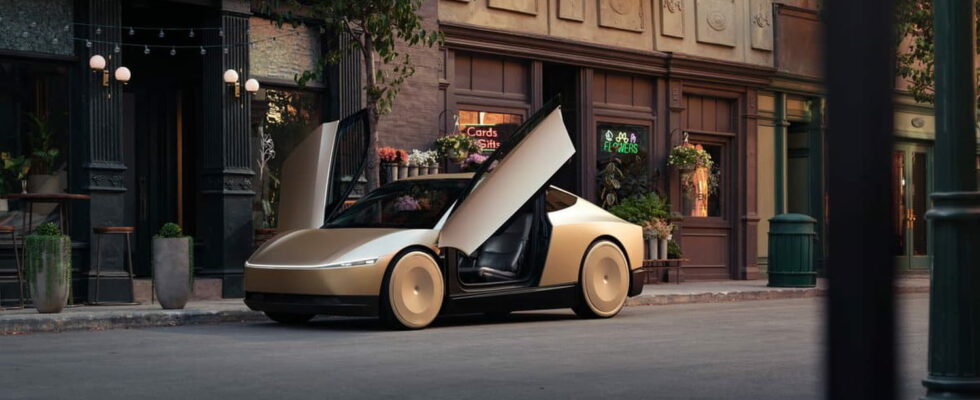True to its innovative approach, Tesla has just officially presented its Cybercab, a new generation autonomous vehicle which intends to revolutionize urban automobile transport. A bold bet!
Tesla has once again struck hard by unveiling its brand new futuristic project: the Cybercab. This autonomous electric vehicle, presented during the “We, Robot” event, broadcast online on October 11, 2024, promises to revolutionize urban transport. Contrary to what one might think, this robot taxi is not only intended for professionals, but also for individuals, opening the door to a new era of shared and automated mobility. This ambitious project, which seems straight out of a science fiction film, marks a crucial step in Tesla’s vision for the future of the automobile.
Tesla Cybercab: an original autonomous vehicle
THE Cybercab is a fully autonomous taxi, designed to operate without human intervention. It has no steering wheel or pedals, as its operation relies entirely on advanced autonomous driving technology. Its design is resolutely futuristic, with butterfly doors reminiscent of the Model X from Tesla, but the interior is minimalist, accommodating only two passengers. The particularity of this taxi is that it is accessible to individuals, and not reserved for transport companies. An owner will be able to use it as they wish and, when they don’t need it, make it available to other users via an application similar to Uber.
The Cybercab presents a significant innovation: it uses an induction charging system. This means that the vehicle charges wirelessly by placing it on a special station. No need to plug in a cable to replenish your energy, which is part of Tesla’s desire to make the user experience as smooth as possible. However, these charging stations, which are still in the development phase, will need to be installed in major cities for the Cybercab to operate at full capacity.
Tesla Cybercab: an economic model geared towards sharing
Elon Musk unveiled an innovative economic model for Cybercab. By purchasing this vehicle for around $30,000, an individual could not only use it for travel, but also rent it to other people via a dedicated mobile application. This would make its investment profitable while contributing to the reduction of traffic jams and the fluidity of urban traffic. According to Musk, the cost of using Cybercab could be up to five times lower than public transportation, with an estimated cost per mile of $0.20.
This idea of “individualized public transportation” relies on the continued availability of autonomous vehicles. When they are not in use by their owner, they can be called on demand by other users, which would optimize their use and limit the need for individual cars.
The challenges to be met
Despite the enthusiasm generated by this announcement, several challenges remain for the Cybercab become a reality. First of all, the legislation around autonomous vehicles is not uniform, and Tesla will need to obtain approval from local authorities before it can deploy these driverless taxis on the roads. In the United States, states like California and Texas, where Tesla plans to launch its service in 2026, already have regulations favorable to autonomous vehicles. However, in other regions, notably in Europe, the laws are stricter and could delay the arrival of the Cybercab.
Next, the reliability of the autonomous driving technology must be proven. Tesla has already encountered controversy with its systems Autopilot And Full Self-Driving (FSD), and accidents involving autonomous vehicles have raised concerns about their safety. Although Elon Musk claims that self-driving cars will be 10 to 20 times safer than those driven by humans, regulators and the general public remain skeptical. For a car without a steering wheel or pedals to be accepted, Tesla will have to prove that its technology is 100% reliable.
Finally, the cost and implementation of the necessary infrastructure, such as inductive charging stations, also represents an obstacle. If Tesla fails to deploy these stations on a large scale, the use of Cybercab could be limited.
Tesla Cybercab: an imminent revolution in urban transport?
With the CybercabTesla is continuing its diversification strategy, combining electric vehicles, robotics and artificial intelligence. Elon Musk has always dreamed of a future where self-driving cars dominate the roads, and the Cybercab could well be the embodiment of this vision. However, despite Tesla’s ambitious promises, there are still obstacles to overcome before this vehicle becomes a reality accessible to everyone.
If everything goes as planned, the Cybercab could redefine the urban landscape and transform our transportation habits. It is no longer just a technological innovation, but a complete overhaul of the way we think about mobility in our cities. In 2027, the question may no longer be “How will we get around?” but “Do we still have to drive?” Tesla, with his Cybercabseems to have already found the answer.

